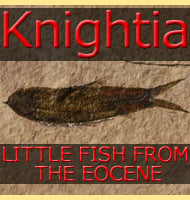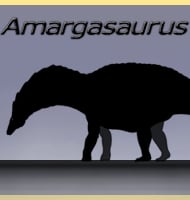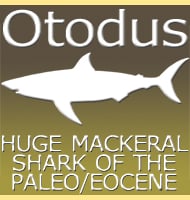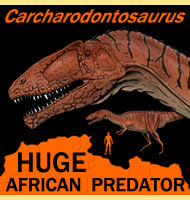In Depth
Perhaps the most striking feature of Tenontosaurus is the tail which actually takes up more than half the total body length. This tail was supported by a network of strong tendons which ensured it was always carried erect off the ground. It is in reference to these tendons that Tenontosaurus was given its name in 1970. However the first Tenontosaurus remains were discovered in 1903, and later it was given the informal name of ‘Tenantosaurus’ by Barnum Brown. Because this name was informal it is not regarded as a synonym, and the re-spelled version of Tenontosaurus by John Ostrom is now its scientifically recognised name.
Over the years there have been over sixty specimens of Tenontosaurus recovered, strongly suggesting that it would have been a common sight during the Aptian and Albian periods of the Cretaceous. Many of these remains also have preserved fossils of the carnivorous dinosaur Deinonychus, especially the teeth of these predators. One fossil site also has five Deinonychus individuals fossilised in close proximity to the remains of a Tenontosaurus. This has been interpreted as evidence of pack hunting in these dinosaurs although it is by no means conclusive proof.
Study of the fossil sites and the periods they come from has brought the suggestion that Tenontosaurus could adapt to life in different kinds of environments. The start of the Albian period was known for its arid conditions, but as time progressed it steadily grew wetter into a tropical climate featuring river deltas and swamps during the wet seasons to a savannah climate during the dry. Despite these changing climates, Tenontosaurus continued to thrive as evidenced from its numerous remains in the fossil record.
As a dinosaur Tenontosaurus was once classed as a hypsilophdontid until that group was restructured, the result of which has seen Tenontosaurus now classified as a primitive iguanodont. Because of its long forelimbs and strong finger bones, it seems that Tenontosaurus was primarily quadrupedal. It is however likely that the long tail would have worked as an effective counterbalance, allowing Tenontosaurus to rear up on its hind legs to reach a greater range of plant material that would have been out of reach of other low browsers. Tenontosaurus is one of many dinosaurs to have medullary bone tissue found on their femurs. Study of other specimens suggests that these dinosaurs were able to reproduce before they were fully grown.
Further Reading
– Stratigraphy and paleontology of the Cloverly Formation (Lower Cretaceous) of the Bighorn Basin area, Wyoming and Montana. Peabody Museum Bulletin 35:1-234. – J. H. Ostrom – 1970. – The paleoecology of the ornithopod dinosaur Tenontosaurus tilletti from the Cloverly Formation, Big Horn Basin of Wyoming and Montana. – The Mosasaur, 2: 151–163. – C. A. Foster – 1984. – Taphonomy and paleobiological implications of Tenontosaurus-Deinonychus associations. – Journal of Vertebrate Paleontology. 15 (4): 707–712. – W. D. Maxwell & J. H. Ostrom – 1995. – A new species of Tenontosaurus (Dinosauria: Ornithopoda) from the Early Cretaceous of Texas. – Journal of Vertebrate Paleontology 17(2):330-348. – D. A. Winkler, P. A. Murry & L. L. Jacobs – 1997. – The Ontogenetic Osteohistology of Tenontosaurus tilletti. – PLoS ONE. 7 (3): e33539. – S. Werning (Andrew A. Farke, ed.) – 2012.










